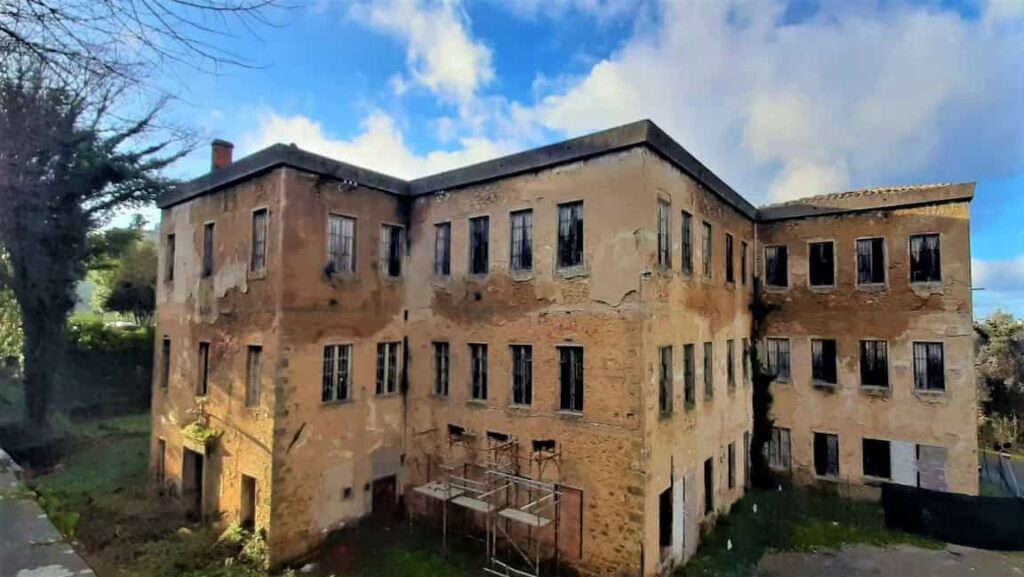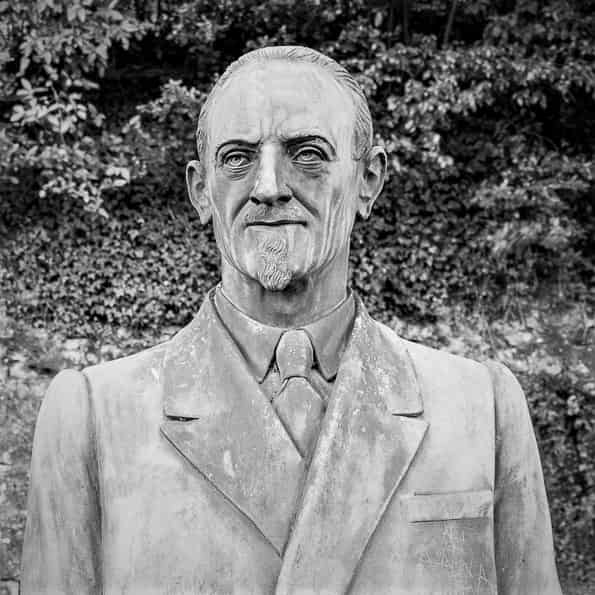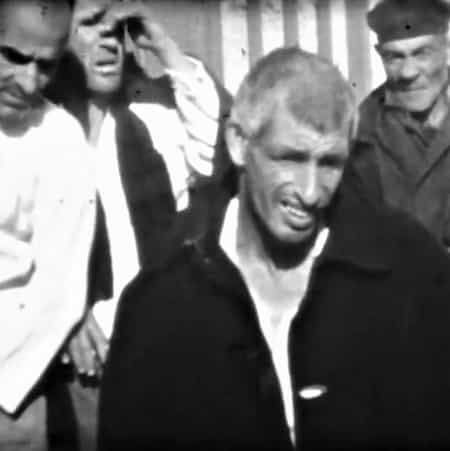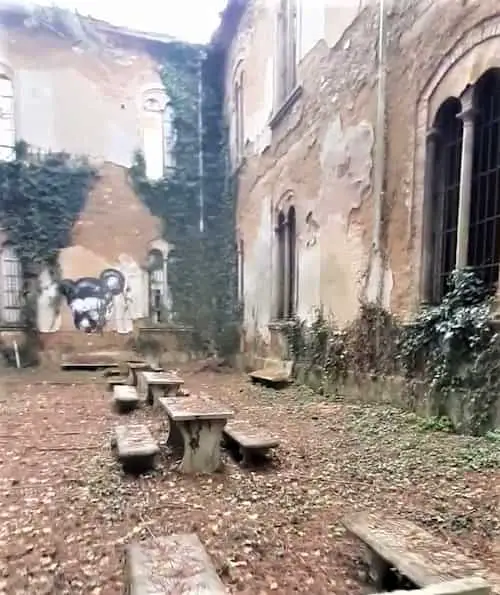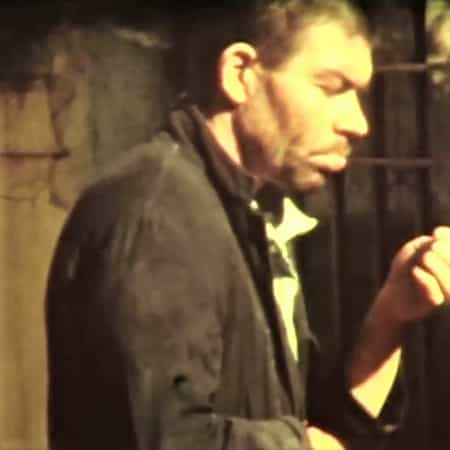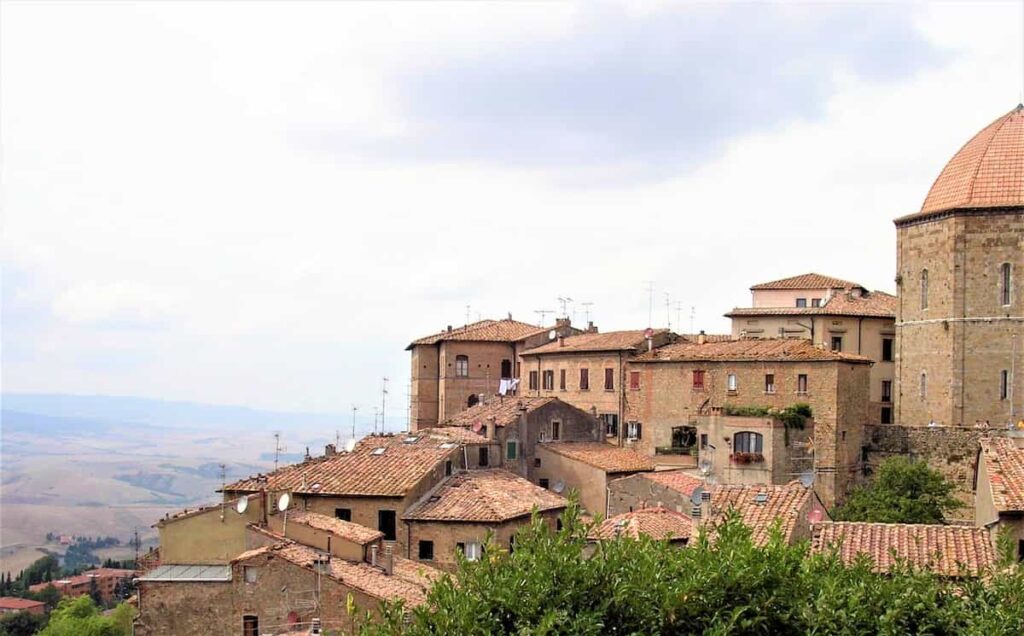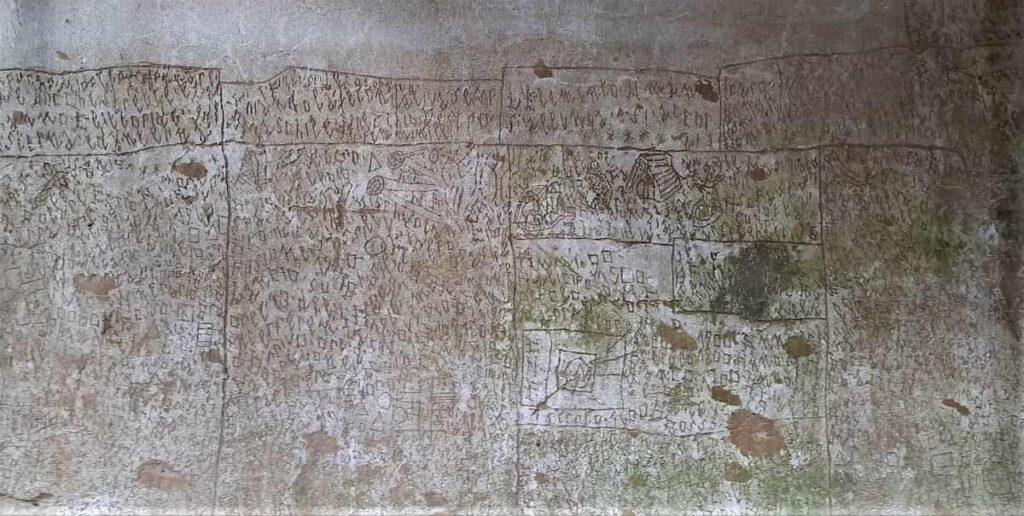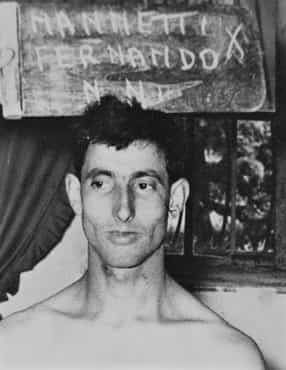Volterra psychiatric hospital – Ospedale Psichiatrico di Volterra.
The history of Volterra psychiatric hospital.
When the hospital was established and why.
The Ospedale Psichiatrico di Volterra was established in 1888 as a part of the charity congregation, an Italian institutionalized effort to help the poor. The psychiatric ward was set up inside the grounds of the 15th-century convent San Girolamo. Interestingly, it was labeled “Moral agency”.
Today, it is not one building but several pavilions, spread out inside a beautiful forest situated on the hillside west of the city. During the decades and with increasing requests from the surrounding area as well as from other parts of the country, the hospital increased its capacity to receive patients. In the mid-1900s it was the biggest psychiatric hospital in Italy.
The modest first years of Ospedale Psichiatrico di Volterra.
In the late 1800s, mental health care didn’t have much to do with the word care. Many people with mental illnesses were frequently treated as outcasts that needed to be hidden away. The hospital’s goal obviously was to provide therapy and support to the patients. But in reality, mental hospitals at that time were much more warehousing than actual medical treatment.
From around 1900 until 1934, the manager of the hospital was Luigi Scabia. Although firmly rooted in the ideas of the 19th century, he introduced new projects to the institution. His goal was to create an internal universe inside the hospital. A world with jobs, recreation, and even some sort of family structure. He created a carpentry shop, a bakery, a laundry, an electrical workshop, and even a furnace for making bricks to be used in the pavilions to be built. For a period the hospital even had its own postal service as well as a currency for use inside the premises.
In these years new buildings were added. And the patients were divided into sections based on the type of treatment required. There was a pavilion for agitated patients, and another for those who were calmer. There were pavilions for patients affected by infectious diseases. In 1933 due to the increased number of patients the Maragliano Pavilion was built. This building was a sanatorium exclusively for male TB patients.
When the second world war broke out, Volterra psychiatric hospital had become a vast structure that could house thousands of patients. In 1900 the average daily number of patients in the hospital was not more than 150. In 1939 that number was 4794.
Ospedale psychiatrico do Volterra after Luigi Scabia and after the war.
The years following the biggest conflict the world has ever seen were hard in Italy. Resources were lacking on all fronts, and budgets for psychiatric care were easy and straightforward to cut. So, the clinical ideas of Scabia were slowly abandoned for a more authoritative and rigid regime.
One could say that caring for the mentally ill in Volterra psychological hospital degraded in the forties and fifties. The reasonably caring hand of Luigi Scabia was gone, and the years of the fascist regime and the war had made an impact on how society looked upon “mad” people.
To that came the construction of the huge Ferri pavilion. This was a Judicial department with new types of patients… Criminals, and political prisoners. We can read in the documents how nurses and other medical personnel were called Guards, and how the patients were labeled Interns.
From 1963, the conditions inside the hospital very slowly started to improve. It would take until 1973 to see any real difference, though. The funds were unprioritized and the hospital was notoriously overcrowded.
Treatment methods used at the hospital have changed over time.
The hospital’s treatment strategies changed as medical knowledge increased. But it also depended largely on funds and willingness to help those unfortunate enough to be committed. The strong influence of scientific racism that swept over Europe during the 1920s and 1930s threatened even the idea of any treatment whatsoever of the mentally ill.
At Volterra psychiatric hospital, Scabia, who was a follower of the so-called positivism and the philosopher Roberto Ardigò, had already introduced no-restraint practices. That should not be confused with total freedom to do what you want. The idea was that forced restrainment and blunt violence should be used to a less degree.
After the war and as time proceeded new methods were tried out in psychiatric care. Many of those methods didn’t do anything to help though. Instead, the goal of the treatment was often to make the troubled patient more compliant, e.g. sedated. And if drugs weren’t readily accessible, the way to make mentally ill patients compliant was by going back to restraint and violence, or by threats of restraint and violence. Methods that Scabia had already limited 40 years earlier.
In the 50s and 60s treatments like insulin shock therapy, electroconvulsive therapy (ECT), and psychotropic drugs started to gain acceptance. But just as in the case earlier, these methods were very often used without any real understanding of their effect, efficiency, or even side effects. Some patients saw improvements in their conditions, but, again, the effects were very random.
Disputes involving the hospital, such as allegations of patient mistreatment.
Much like other Psychiatric hospitals, The Volterra psychiatric hospital has experienced many claims of staff mistreating and abusing patients throughout its history. Numerous former patients have spoken out to share their experiences of being mistreated, restrained, and put through experimental treatments without their permission.
There are many testimonies of neglect, unhygienic conditions, restraining by physical force or coercion, and a generally violent environment. These reports are much more common from the period during and from the decades after the war than from earlier times.
In 1978, the hospital was closed.
In 1978, the so-called Basaglia Law (law 180) made big Psychiatric hospitals in Italy superfluous. They were gradually replaced with a whole range of community-based services. So, The Volterra psychiatric hospital was closed and the patients were moved to other locations or released into the neighborhood. Some of the buildings were left to deteriorate, of them the infamous Ferri pavilion.
The hospital village created by Luigi Scabia is still in use today. The Santa Maria Maddalena hospital operates several healthcare facilities. There are two hotels and even a museum covering the history of the psychiatric hospital. From here you can also visit the buildings otherwise closed to the public.
The hauntings of the Volterra psychiatric hospital.
The abandoned halls and decaying structures of the Ospedale Psichiatrico di Volterra are rumored to be haunted by the spirits of former patients. Over the years, reports of ghostly sightings and paranormal activity in and around the buildings of the hospital have surfaced, attracting ghost hunters from around the world. But reports are not evidence. It’s at the very best, reports. And sometimes not even that.
Reports of ghost and paranormal activity within the hospital.
Many visitors to the hospital have reported seeing shadowy figures, and feeling a sense of unease or fear while exploring the premises. Some have claimed to have seen the ghostly apparitions. When contact with the spirits is established (almost always through an EVP recorder) the identity is always of former patients of the hospital.
Many claims to have heard footsteps, whispers, and voices crying out. And some have experienced sudden changes in temperature, and things moving around.
What is said is that the ghosts are patients of the hospital who died there, who were treated cruelly or unjustly, who were experimented upon, and similar stories. Their names are many, and according to the “experts”, they can be found all over the area. Local investigators claim that ghostly apparitions are typically concentrated in and around the Ferri pavilion. Another supposedly haunted location is the cemetery Sanfinocchi a mile (1,5 km) to the north.
The Ferri pavilion was, until 1962, more of a prison than a psychiatric ward. It was isolated by walls and barbed wire surrounded the whole building. There was a large gate at the entrance guarded day and night by the staff of the ward. Today it’s a ruin.
Accounts of patients who died in the hospital and their restless spirits:
The general idea is that the souls of those who died at the hospital remain trapped within the decaying buildings, unable to find peace. It is easy to see some logic to that. A mental institution from the past is a perfect stage for all kinds of scary performances. The tragic life of the recluded patients tells us something about how cruel and heartless society can be. It is also a witness of the very thin line between either us being looked upon as humans or being regarded as something else and as such being denied even basic human rights. Once you divide humanity in this and that, we and them, atrocities become possible.
At one time as many as 6000 patients were living in Volterra psychiatric hospital. That gives plenty of possible ghosts if we look at the criteria above.
Legends of the hospital being cursed or haunted by a malevolent spirit.
Ghosts of former patients are unsettling enough. But there are also darker legends from much older times. The church of San Girolamo and the attached Franciscan convent was built in the 15th century. The chosen site accidentally was on top of an old, abandoned Etruscan burial place. In fact, when the foundation for the buildings was dug, the old graves were destroyed and bones from hundreds of dead were scattered around the neighborhood. The long-dead bodies were so disturbed that they awakened something that had been dormant. And that entity is much more dangerous than mumblings on EVPs or moving chairs. Because that is a demon.
Conclusive investigations in and around Ospedale Psichiatrico di Volterra.
And this is as usual shorter and less intriguing part of the article. Because although there are truckloads of homemade or semi-professional documentation, very little has any real data to show.
In 2006 the Italian Society of Parapsychology investigated the premises. They didn’t find any paranormal activity at all.
Italian YouTubers frequently visit the hospital, and there are many reported encounters with ghosts and phantoms. But the amount of videos being presented as proof of these encounters is much less in later years, because of the buildings being closed to the public.
And that leads us to an interesting reflection: The environment itself is very attractive as a location for supposed hauntings. After the closure in 1978, the various pavilions encountered different destinies. Some were abandoned while others were restored, refurbished, and are now in use. These latter don’t seem to have any paranormal activity in them at all. The modern hospital facilities are “clean” although they share the history with the crumbling ruins further up the street.
Could it be that ghosts generally prefer locations that are old, rusty, dark, and spooky? Or is it that these ambients are better suited for video recording?
A ghost caught on film.
Still, some small indications of hauntings creep forth every now and then. As in this video from 7 years ago. A small group of young YouTube ghost hunters is filming outside the Ferri pavilion. The guy in the center is talking about the famous Nof-wall, while something is seen in the lower right corner of the window behind him, immediately to the left of his glasses.
The video is in Italian but here are the time stamps:
- 2.21 Normal speed and color.
- 2.34 Normal speed. Lightened.
- 2.38 Normal speed. Lightened. Zoomed.
- 2.52 Slow motion. Lightened. Zoomed.
That’s it. Now you make up your own mind.
Final thought.
The history of Ospedale Psichiatrico di Volterra is very interesting. It is an important testimony of local events in and around the city of Volterra, and of life and health care in the 20th century.
But much more important is the picture it paints of how mental patients have been abused, mistreated, and oppressed over the centuries.
My own take on it is that we, as humans, have a strong inclination to see the world in terms of we-them, and in-out. That way of thinking leads to a defective worldview. We feel we need to defend our little group from the other groups. That can be the correct feeling if our nation is invaded by soldiers with weapons.
But if we give in to that sort of feeling without reflecting on its usefulness, we can possibly see threats from any kind of outgroup… People from other nations who are not invading us, people with another skin color, people of another gender, people of another faith, and of course crazy folks. And if so the only thing that holds us back from committing atrocities is the fact that we anyway see them all as humans, just like us. When that final frontier breaks, the true horrors begin.
Conclusion
Not very haunted. One extra star is conceded for the history of the hospital and its extraordinary environment. More stars will be given if the video above can be confirmed as having recorded a real spectral entity.
Facts about Volterra psychiatric hospital.
- The Volterra psychiatric hospital was established in 1888 and closed in 1978.
- It was the largest psychiatric hospital in Italy.
- The total area was 100 acres (40 hectares).
- The total building area was 320,000 square feet (30.000 square meters), distributed in 13 wards/buildings.
- Most of the area is cordoned off but some of the abandoned buildings that are not in use can be visited through the contact below.
- For visiting, contact Mueso Lombroso at +39 0588 86099

Facts about Nof4, the artist.
Nof4, Enrico Zaccarini, was a well-known Italian painter who spent a significant portion of his life at the Volterra psychiatric hospital. He was born in Faenza and began painting at a young age. He studied Arts at the Bologna Academy of Fine Arts, but it was his time at the Volterra psychiatric hospital that would influence his artistic style and career in an explicit and definitive way.
Nof4 lived from 1948 until 1973 in mental institutions. First in Rome and from 1958 at the Volterra psychiatric hospital. Between 1959 and 1961 he stayed at the Ferri pavilion. While locked up there he completed graffiti that covered the outside wall in a total length of 180 meters, the so-called Nof wall. After his release, he continued living in Volterra until his death in 1994.
